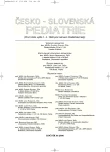Glomerulonephritis in Pediatric Practice – Most Frequent Clinical Units, Etiopathogenesis, Therapy and Prognosis
Authors:
K. Vondrák; J. Janda
Authors‘ workplace:
Pediatrická klinika 2. LF UK, FN Motol, Praha
přednosta prof. MUDr. J. Lebl, CSc.
Published in:
Čes-slov Pediat 2006; 61 (11): 657-665.
Category:
Postgraduate Education
Overview
The authors present the diagnostic procedure in children with glomerulonephritis. Most frequent types of glomerulonephritis are described as well as their differential diagnosis, prognosis and therapy. Most frequent urinary findings are listed – syndromes which correspond to individual types of glomerulonephritis and indications for renal biopsies are discussed. In conclusion the authors outline their opinions about life regimen, school attendance and physical load.
Key words:
acute, chronic, rapidly progressing glomerulonephritis, urinary syndromes, renal biopsy, therapy of glomerulonephritis
Labels
Neonatology Paediatrics General practitioner for children and adolescentsArticle was published in
Czech-Slovak Pediatrics

2006 Issue 11
Most read in this issue
- Glomerulonephritis in Pediatric Practice – Most Frequent Clinical Units, Etiopathogenesis, Therapy and Prognosis
- Louis-Bar Syndrome of Ataxia Telangiectasia in Consanguinous Family
- Juvenile Idiopathic Arthritis from the Very Cruel Side
- Infection of Urinary Pathways in Adolescent Girls
